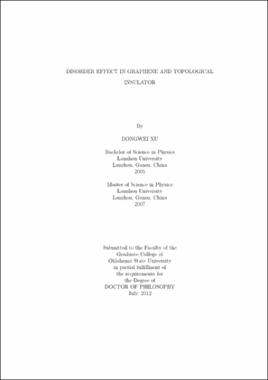| dc.contributor.author | Xu, Dongwei | |
| dc.date.accessioned | 2013-11-26T08:26:38Z | |
| dc.date.available | 2013-11-26T08:26:38Z | |
| dc.date.issued | 2012-07 | |
| dc.identifier.uri | https://hdl.handle.net/11244/6921 | |
| dc.description.abstract | Scope and Method of Study: | |
| dc.description.abstract | Disorder effect on graphene and topological insulators are the main focuses in this dissertation. Tight-binding model is mainly used to carry out the research. The disorder effect is modeled by introducing random distributed energies in a certain interval. The electron transport properties are studied using non-equilibrium Green's function method. Firstly, disorder induced field effect transistor (FET) in biased bilayer and trilayer graphene is proposed. A full band model Hamiltonian for multilayer graphene is employed to disclose the physical mechanism responsible for the disorder induced FET. Secondly, we study the disordered topological Anderson insulator (TAI) in a 2-D square geometry. Besides tight-binding model, effective medium theory (SCBA) is employed to predict the phase boundary. | |
| dc.description.abstract | Findings and Conclusions: | |
| dc.description.abstract | In the study of FET in biased multilayer graphene, the substrate is modeled by including disorder in the bottom graphene layer. The disorder effect on the conductance depends on the direction of the bias voltage. The ratio of conductances under opposite bias voltages is obtained, and it increases with disorder strength and voltage magnitude. The high peaks of the conductance ratio suggest that disorder can increase the FET efficiency. In this proposed FET, an energy gap is not required for the 'off' state. In the study of disordered TAI, we report the phase diagram of finite systems and study the evolution of phase boundaries with the increase of the system size. We establish that conductance quantization can occur without a bulk band gap, and that there are two distinct scaling regions with quantized conductance: TAI-I with a bulk band gap, and TAI-II with localized bulk states. We show that there is no intervening insulating phase between the bulk conduction phase and quantized regions, and that there is no metallic phase at the transition between the quantized and insulating phases. In a large portion of the conductance plateau eigenstates grow when the disorder strength is increased. The fractal dimension at the peak maximum is d2=1.5. We report conductance distributions near several phase transitions and compare them with critical conductance distributions for well-known models. | |
| dc.format | application/pdf | |
| dc.language | en_US | |
| dc.rights | Copyright is held by the author who has granted the Oklahoma State University Library the non-exclusive right to share this material in its institutional repository. Contact Digital Library Services at lib-dls@okstate.edu or 405-744-9161 for the permission policy on the use, reproduction or distribution of this material. | |
| dc.title | Disorder effect in graphene and topological insulator | |
| osu.filename | Xu_okstate_0664D_12232 | |
| osu.accesstype | Open Access | |
| dc.type.genre | Dissertation | |
| dc.type.material | Text | |
| dc.subject.keywords | disorder effect | |
| dc.subject.keywords | graphene | |
| dc.subject.keywords | topological insulator | |
| thesis.degree.discipline | Physics | |
| thesis.degree.grantor | Oklahoma State University | |
